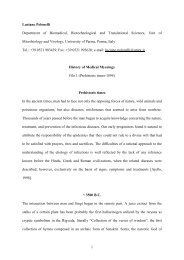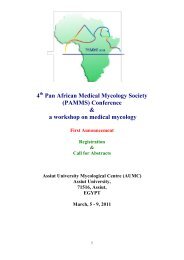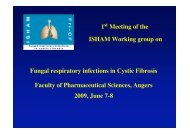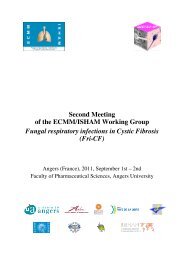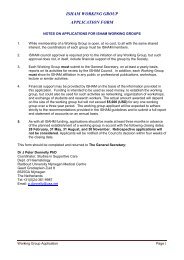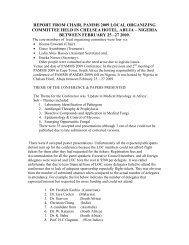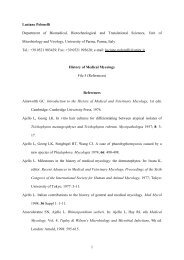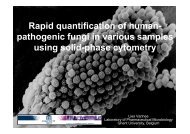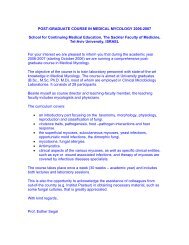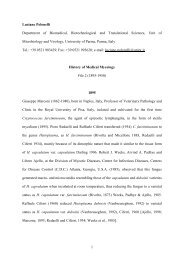Memoria CD.indd - ISHAM
Memoria CD.indd - ISHAM
Memoria CD.indd - ISHAM
Create successful ePaper yourself
Turn your PDF publications into a flip-book with our unique Google optimized e-Paper software.
Although drug serum levels are an objective measure of drug intake, they provide only a snapshotof behavior and can be affected by factors other than adherence.Indices obtained by using a questionnaire and laboratory charts, with drug measure (sulfonamideserum level) and antifungal effect (serological curve) were compared. Our study revealed correlationbetween individual clinic attendance compliance and serological curve. However, descending serologicalcurves were observed in patients with lower sulfonamide serum levels. These findings couldbe explained by intake failure in the appointment day, when fasting patients are submitted to bloodtests. Thus, patients are told to take only the medication before having their blood draw. It can also behypothesized that adequate sulfonamide serum level was overestimated. Alcohol intake, family helpand education level played a mild role in treatment compliance. The high values of combined complianceindices provided a more accurate evaluation, and demonstrated high quality of medical care.Guidelines for the treatment of paracoccidioidomycosisFlavio Queiroz-TellesServiço de Infectologia, Hospital de Clinicas, Universidade Federao do Paranáe-mail: queiroz.telles@uol.com.brEvidence-based guidelines for the management of patients with Paracoccidioidomycosis (PCM)were prepared by an Expert Panel of the Brazilian Societies of Infectology and Tropical Diseases.The guideline was published two years from now (Ver. Soc. Bras. Med. Trop. 39(3):297-310, 2006)aiming to help the clinicians to manage most of the clinical forms of the disease. PCM is consideredto be the most important systemic endemic mycosis affecting South America. The prevalence of thisinfection varies among regions of endemicity, and it is estimated that the incidence of PCM rangesfrom 1 to 3 cases per 100,000 inhabitants in regions where the disease is endemic. However, becausethe reporting of PCM is not compulsory, it is difficult to determine accurately the number ofpeople affected by the disease. Without treatment, the natural evolution of the disease is typicallydeath. In patients with immunosuppression, such as AIDS, the infection can progress to full-blowndisseminated disease.P. brasiliensis differs from other pathogenic fungi, because it is a very sensitive organism whenexposed to antifungal drugs; even sulfonamides can inhibit its growth. A large therapeutic armamentariumis available for patients with PCM.Several classes of antimycotic drugs have been used in the treatment of this systemic mycosis,including sulfonamides (sulfadiazine, sulfadoxine, sulfamethoxypyridazine, cotrimazine, and cotrimoxazole),Amphotericin B, azoles (ketoconazole, itraconazole, fluconazole and voriconazole), andterbinafine. The cure rates achieved with these various drugs have ranged between 69% and 100%.To date, no antifungal resistance has been demonstrated in PCM.Itraconazole is considered the standard treatment for mild and moderate clinical forms of PCM.This recommendation is based on the results from a non comparative study of 47 patients, most ofwho had multifocal disease and received itraconazole for a mean duration of 6 months. A scoringsystem indicated a favorable response in 43 patients (89%). In another trial, 90 patients with provedPCM were treated with cotrimoxazole or itraconazole and evaluated for clinical and microbiological;response, safety and tolerability. The final analysis showed that itraconazole is more effective and bettertolerated than cotrimoxazole (trimethoprim-sulfamethoxazole) in the treatment of mild to moderatedPCM. In addition, the mean duration of treatment with itraconazole is significantly shorter (7 monthsversus 24 months, p



